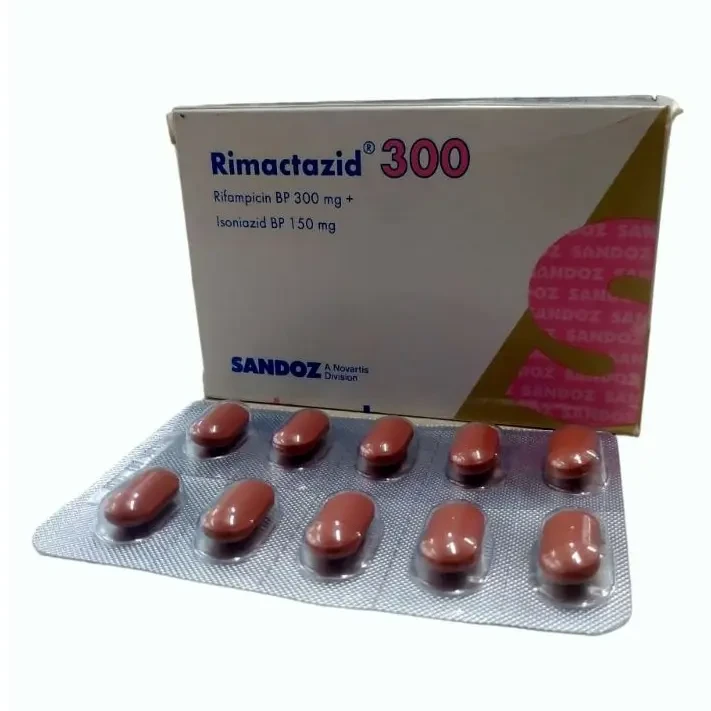
✔ 100% Authentic Product
👁️ Currently Viewing 3482
Rimactazid 300/150mg Tablet 1 Strip
Rimactazid (Rifampicin 300mg + Isoniazid 150mg) is part of a group of medications known as antituberculosis agents. This combination consists of two highly effective drugs that inhibit the growth of mycobacteria responsible for causing tuberculosis. It is specifically used for the continuation phase treatment of tuberculosis.
Use under the guidance of a registered physician.
Discount
Price: ৳ 80
MRP:
৳
84
5%
Off

100% Genuine Products, Guaranteed

Safe & Secure Payments, Always

Fast, Secure & Efficient Delivery

Proper Packaging
 Cash on Delivery - All over Bangladesh
Cash on Delivery - All over Bangladesh Regular Delivery - 12-24 Hours, Dhaka City* Charge Tk.39-59
Regular Delivery - 12-24 Hours, Dhaka City* Charge Tk.39-59 Regular Delivery - 24-48 Hours, Other Cities* Charge Tk.99-110
Regular Delivery - 24-48 Hours, Other Cities* Charge Tk.99-110
 ফ্রি ডেলিভারিঃ - ৯৯৯ টাকা+ অর্ডারে, ঢাকা
শহরে
ফ্রি ডেলিভারিঃ - ৯৯৯ টাকা+ অর্ডারে, ঢাকা
শহরে ফ্রি ডেলিভারিঃ - ২৯৯৯ টাকা+ অর্ডারে, ঢাকার
বাহিরে
ফ্রি ডেলিভারিঃ - ২৯৯৯ টাকা+ অর্ডারে, ঢাকার
বাহিরে
100% Genuine Products, Guaranteed
Safe & Secure Payments, Always
Fast, Secure & Efficient Delivery
Proper Packaging
 Cash on Delivery - All over Bangladesh
Cash on Delivery - All over Bangladesh Regular Delivery - 12-24 Hours, Dhaka City* Charge Tk.39-59
Regular Delivery - 12-24 Hours, Dhaka City* Charge Tk.39-59 Regular Delivery - 24-48 Hours, Other Cities* Charge Tk.99-110
Regular Delivery - 24-48 Hours, Other Cities* Charge Tk.99-110 ফ্রি ডেলিভারিঃ - ৯৯৯ টাকা+ অর্ডারে, ঢাকা
শহরে
ফ্রি ডেলিভারিঃ - ৯৯৯ টাকা+ অর্ডারে, ঢাকা
শহরে ফ্রি ডেলিভারিঃ - ২৯৯৯ টাকা+ অর্ডারে, ঢাকার
বাহিরে
ফ্রি ডেলিভারিঃ - ২৯৯৯ টাকা+ অর্ডারে, ঢাকার
বাহিরে
✅ Description:

✔️ Side Effects of Rimactazid 300
- General: Reddish discoloration of body fluids (e.g., urine, sweat, tears) caused by rifampicin, which can permanently stain contact lenses.
- Hepatic effects: Commonly seen as elevated liver enzymes. Severe reactions like liver failure or acute hepatitis are less common but can be life-threatening.
- Renal effects: Elevated BUN levels, hematuria, interstitial nephritis, or renal insufficiency.
- Gastrointestinal effects: Nausea, abdominal pain, diarrhea, or pseudomembranous colitis.
- Neurological effects: Fatigue, dizziness, headaches, confusion, or ataxia.
- Hematological effects: Thrombocytopenia, eosinophilia, and leucopenia.
- Skin and allergic reactions: Flushing, urticaria, rashes, or generalized hypersensitivity reactions (e.g., Lyell’s syndrome).
✔️ Dosage & Administration of Rimactazid 300
- For body weight <50 kg:
- 3 tablets of 150/100 mg once daily or 1 tablet of 450/300 mg once daily.
- For body weight >50 kg:
- 2 tablets of 300/150 mg once daily.
- For hepatic impairment: Maximum dose: 8 mg/kg daily.
Use under the guidance of a registered physician.
✔️ Drug Interactions
- Hormonal contraceptives: May reduce their effectiveness.
- Antacids: May decrease absorption.
- Rifampicin:
- Can reduce plasma levels of antivirals (e.g., atazanavir, darunavir), antifungals (e.g., ketoconazole), anticonvulsants (e.g., phenytoin), oral anticoagulants, and other medications such as beta-blockers, corticosteroids, theophylline, and barbiturates.
- May increase the risk of hepatotoxicity when used with halothane.
- Isoniazid:
- May inhibit the metabolism of drugs such as anticonvulsants, benzodiazepines, ketoconazole, and warfarin.
- Can enhance central nervous system effects when combined with medications like meperidine or disulfiram.
✔️ Contraindications
- Hypersensitivity to rifamycins, isoniazid, or any excipients in the formulation.
- History of drug-induced hepatitis or active liver disease.
- Conditions like peripheral neuritis.
✔️ Pregnancy & Lactation
- Pregnancy: Classified as Category C. While animal studies suggest potential risks to the fetus, benefits in managing tuberculosis may outweigh these risks in pregnant women.
- Lactation: Limited evidence suggests potential risks to the infant; consult a healthcare provider before use.
✔️ Precautions & Warnings
- Monitor use in:
- Individuals consuming alcohol daily, as it increases the risk of isoniazid hepatitis.
- Patients with chronic liver disease or severe renal impairment.
- Individuals over 35 years of age or with predisposing conditions such as neuropathy.
- Those taking other long-term medications or with a history of isoniazid discontinuation.
- Postpartum women, HIV-positive patients, and those with a history of injection drug use.
✔️ Storage Conditions
Store below 30°C, away from light and moisture. Keep out of reach of children.
⚠️Disclaimer:
At ePharma, we’re committed to providing accurate and accessible health information. However, all content is intended for informational purposes only and should not replace medical advice from a qualified physician. Please consult your healthcare provider for personalized guidance. We aim to support, not substitute, the doctor-patient relationship.







